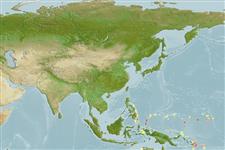>
Gobiiformes (Gobies) >
Gobiidae (Gobies) > Gobiinae
Etymology: Trimma: Greek, trimma, -atos = something crushed (Ref. 45335); hamartium: Name from the Greek word 'hamartia' (ἁμαρτία) m alluding to the author’s error in not recognizing the differences between this species and T. preclarum when describing the latter (the term encompasses 'wrongdoings' which may be either accidental or deliberate)..
Environment: milieu / climate zone / depth range / distribution range
экология
морской ассоциированный с рифами; пределы глубины 7 - 50 m (Ref. 116838). Tropical
распространение
страны | регионы FAO | Ecosystems | места находок | Point map | интродукции | Faunafri
Western Pacific: southwest Palau and probably true for Fiji (paratypes of T. preclarum), Niue, Solomon Is., Indonesia (Mapia Atoll), Australia (GBR) and Kiribati (Abaiang Atoll).
Size / Вес / Возраст
Maturity: Lm ? range ? - ? cm
Max length : 2.5 cm SL самец/пол неопределен; (Ref. 116838)
Краткое описание
морфология | морфометрия
колючие лучи спинного плавника (общее число): 7; членистые (мягкие) лучи спинного плавника (общее число): 9; колючие лучи анального плавника 1; членистые (мягкие) лучи анального плавника: 8 - 9. This species is distinguished by the following characters: no scales on the cheeks and opercle; 8-9 scales in predorsal midline; short second dorsal spine reaching to a mean of the base of the first ray of the second dorsal fin when abducted; pectoral-fin rays 17-19 with 5-10 branched rays in the middle of the fin; an unbranched 5th pelvic-fin ray, 51-64% the length of 4th ray; total gill rakers 17-19; papillae in row c 6, below the eye; U-shaped bony interorbital with a narrow slit-like postorbital trench which ends at the posteriormost papilla in row p; colour when freshly collected, a reddish head with 3-4 yellow bars on the cheek, red iris with four yellow spots, yellow body which is lighter posteriorly, scales pockets outlined with melanophores and scale rows above and below midlateral row much lighter posterior to second dorsal fin origin (giving appearance of three yellow stripes on body); colour when preserved with fairly evenly distributed melanophores over the dorsal surface of the snout (Ref. 116838).
Found in areas with heavy cover of hard corals (Acropora, Pocillopora, Millepora, plate corals, lettuce corals star and cactus corals), variety of sponges, sea whips, ascidians, alcyonarians, tunicates, hydoids (in caves), soft corals, gorgonians, brown encrusting algae; and also on steep reef slopes and almost vertical walls with several large caves with sand/rubble floors, undercuts and small platforms (Ref. 116838).
Life cycle and mating behavior
половая зрелость | размножение | нерест | икра | Fecundity | личинки
Winterbottom, R., 2018. A new species of Trimma (Pisces; Gobiidae) from the South-West Islands of Palau, western Pacific Ocean. Zootaxa 4370(2):123-136. (Ref. 116838)
Статус Красного Списка МСОП (Ref. 130435)
Угроза для людей
Harmless
Использование человеком
дополнительная информация
народные названиясинонимыобмен веществхищникиэкотоксикологияразмножениеполовая зрелостьнерестSpawning aggregationFecundityикраРазвитие икры
Возраст/РазмерыростЗависимость между длиной и массой телаЗависимость между длинамиРазмерный составморфометрияморфологияличинкидинамика численности личинокпополнениечисленностьBRUVS
ссылкиаквакультура (рыбоводство)особенности рыбоводствастепень растяжениягенетикаElectrophoresesнаследуемостьболезниобработкаNutrientsMass conversion
соавторыизображенияStamps, Coins Misc.звукиCiguateraскоростьтип плаванияжаберная областьOtolithsмозгзрение
инструменты
Специальные отчеты
Скачать в формате XML
ресурсы в Интернет
Estimates based on models
Phylogenetic diversity index (Ref.
82804): PD
50 = 0.5000 [Uniqueness, from 0.5 = low to 2.0 = high].
Bayesian length-weight: a=0.00708 (0.00333 - 0.01504), b=3.09 (2.92 - 3.26), in cm total length, based on LWR estimates for this (Sub)family-body shape (Ref.
93245).
устойчивость к внешним воздействиям (Ref.
120179): высокий, минимальное время удвоения популяции до 15 месяцев (Preliminary K or Fecundity.).
Fishing Vulnerability (Ref.
59153): Low vulnerability (10 of 100).
